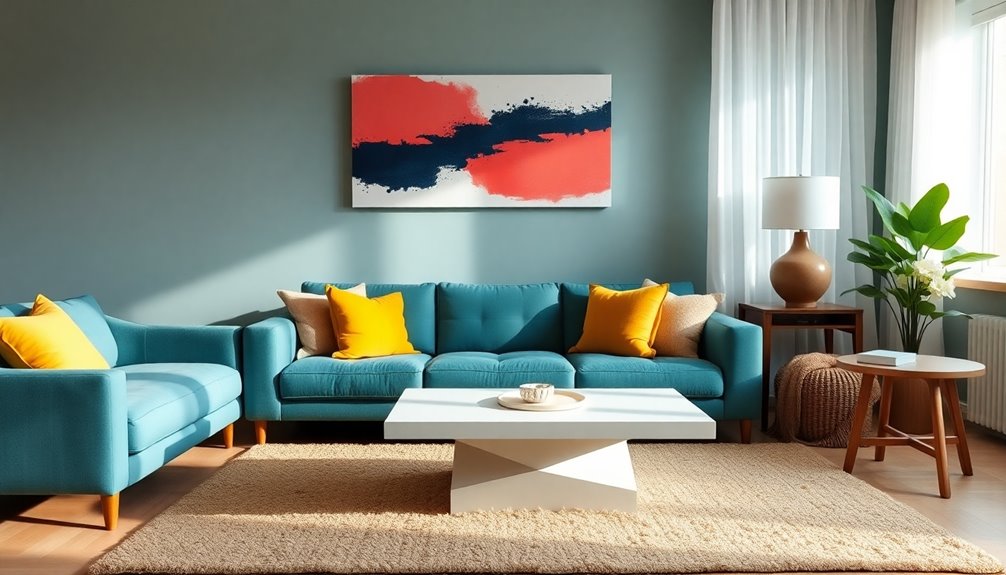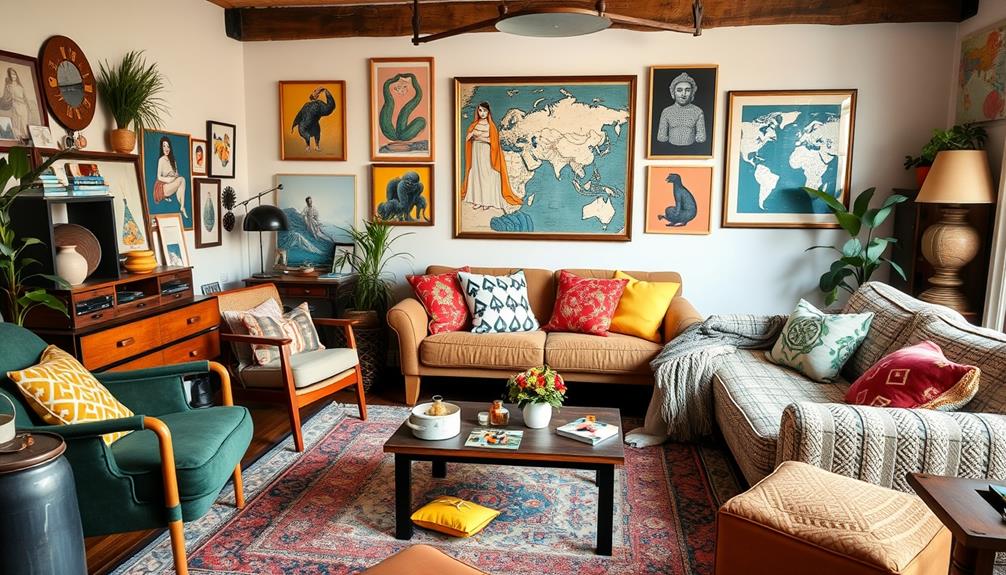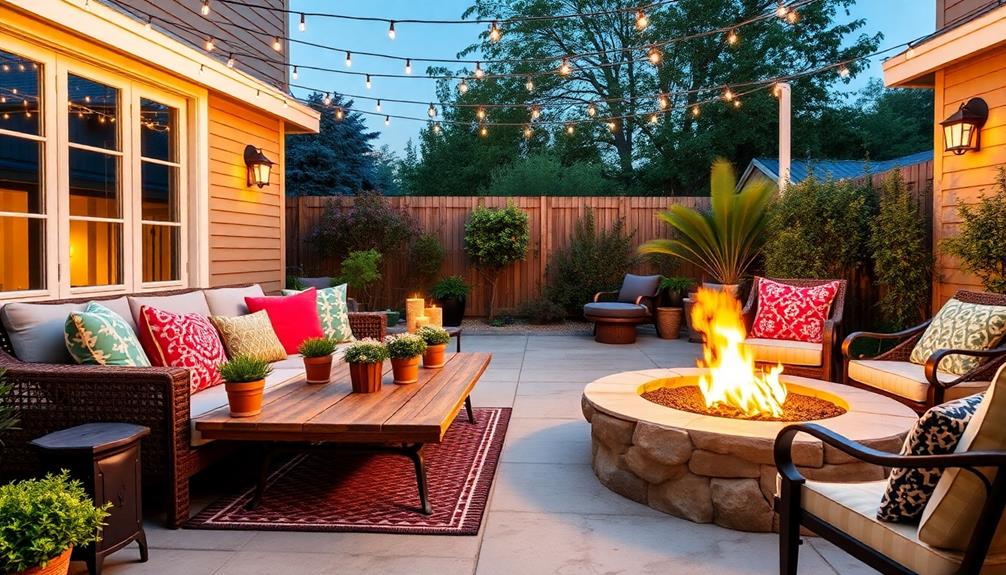To use color blocking in interior design without overdoing it, stick to a limited palette of three to four colors, following the 60-30-10 rule for balance. Focus on strategic placements, like accent walls or furniture, and highlight architectural features with contrasting shades. Incorporate neutral tones to keep things cohesive. Experiment with geometric shapes for added interest, but start small to guarantee harmony. There’s more to explore on how these techniques can transform your space.
Key Takeaways
- Limit your color palette to three or four colors to maintain a cohesive and balanced design without overwhelming the space.
- Use the 60-30-10 rule for color distribution, ensuring one dominant color, a secondary color, and an accent color.
- Focus on one or two accent walls to create focal points while keeping other walls neutral to avoid visual clutter.
- Incorporate geometric shapes and patterns strategically, using painter’s tape for clean lines and defined edges to enhance visual interest.
- Repeat chosen colors in decor and furniture to create harmony and visually tie different areas together throughout the space.
Understanding Color Blocking
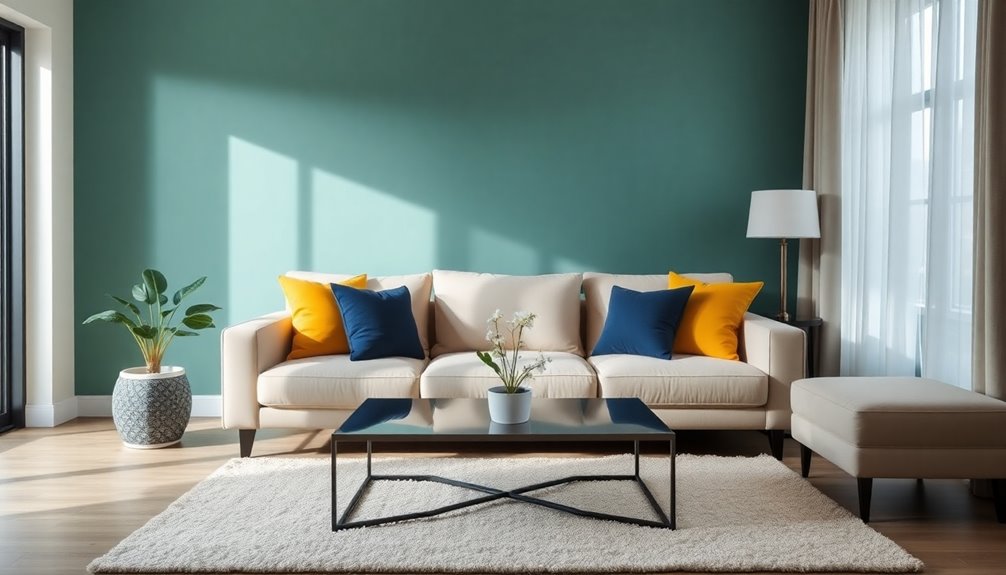
When you explore color blocking in interior design, you’ll find it’s an exciting technique that uses bold blocks of solid colors to create striking visual contrasts. This method can dramatically transform your space, highlighting architectural features and enhancing your design aesthetic.
To effectively use color blocking, understanding color theory is essential. It’ll help you choose harmonious combinations that evoke the moods you want. You can apply this technique to walls, furniture, and decor, making it versatile for any style. Incorporating neutral color schemes can help balance bold colors and maintain a cohesive look throughout your space.
Planning is key; using sketches and painter’s tape guarantees precision, preventing random color placements that could overwhelm your space. Embrace strategic color choices to create a dynamic environment that reflects your personality and taste.
Choosing the Right Color Palette
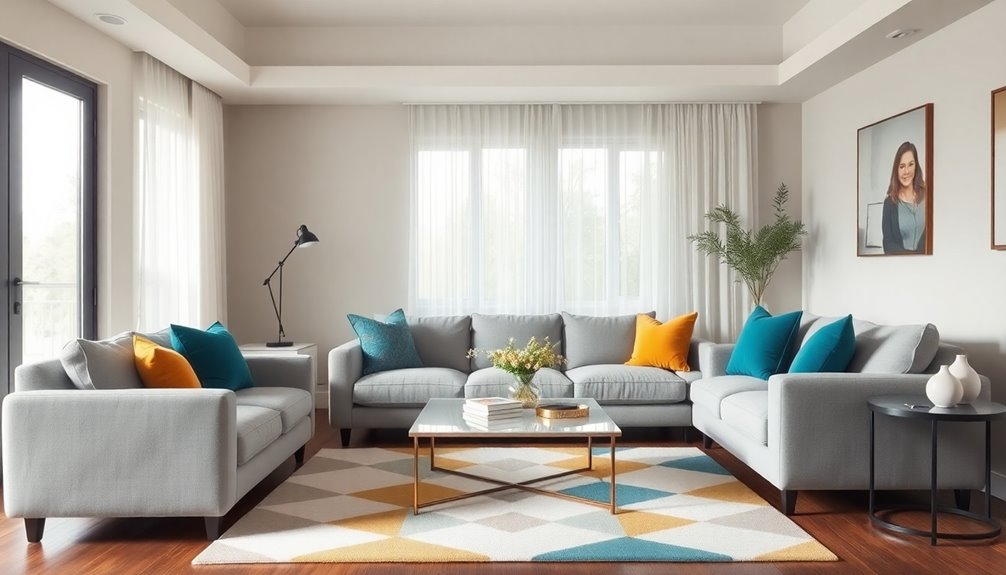
When choosing the right color palette, you’ll want to take into account color theory to create a balanced and harmonious space. Testing color combinations on your walls helps you see how they interact with light and each other. Additionally, consider lighting design as it can significantly influence how colors appear within a room.
Understanding Color Theory
Color theory serves as the foundation for crafting a cohesive and visually appealing interior space. Understanding the relationships between colors on the color wheel is crucial. You can create harmony using complementary, analogous, or triadic schemes.
Also, consider the psychological effects of colors; for instance, blue promotes calmness, while yellow energizes a room. To achieve balanced color distribution, apply the 60-30-10 rule: 60% of your space should be a dominant color, 30% a secondary color, and 10% an accent.
Limit your palette to three or four colors to avoid visual chaos. Make sure these colors complement each other, enhancing your overall aesthetic while maintaining a cohesive look throughout your interior design. Additionally, incorporating floral arrangements can add a natural element that complements your chosen color scheme, further enhancing the atmosphere of your space.
Testing Color Combinations
To create an inviting space, testing color combinations is essential in choosing the right palette.
Start with a color wheel to identify complementary and contrasting colors that work well together. Test color combinations in small areas, like swatches on poster board or sections of a wall, to see how shades interact with natural light throughout the day.
Choose three to five colors that reflect your desired mood, with one dominant color, a secondary accent, and a few neutrals for balance.
Consider using digital design tools to visualize your palette in a virtual setting. Additionally, remember that color psychology can influence the atmosphere of your space, so choose colors that evoke the feelings you want to achieve.
Remember the 60-30-10 rule for proportions—60% dominant, 30% secondary, and 10% accent—to achieve a well-rounded look.
Importance of Balance
Balance is essential in interior design, especially when choosing a color palette. Select one primary color and one or two accent colors to create a cohesive look without overwhelming the space. Mixing light and dark shades maintains visual interest, while complementary or analogous colors enhance serenity. Neutral tones ground your palette, allowing bold colors to shine. Additionally, consider how investment regulations might influence your choices, as investing in quality materials can elevate the overall aesthetic.
Here’s a quick reference table to help you choose your colors:
| Color Type | Example Colors | Purpose |
|---|---|---|
| Primary Color | Blue | Base of the palette |
| Accent Color 1 | Yellow | Add vibrancy |
| Accent Color 2 | Gray | Balance and calm |
| Neutral | White or Beige | Grounding effect |
| Function-Specific | Soft Greens (bedroom) | Promote relaxation |
Strategic Placement of Colors
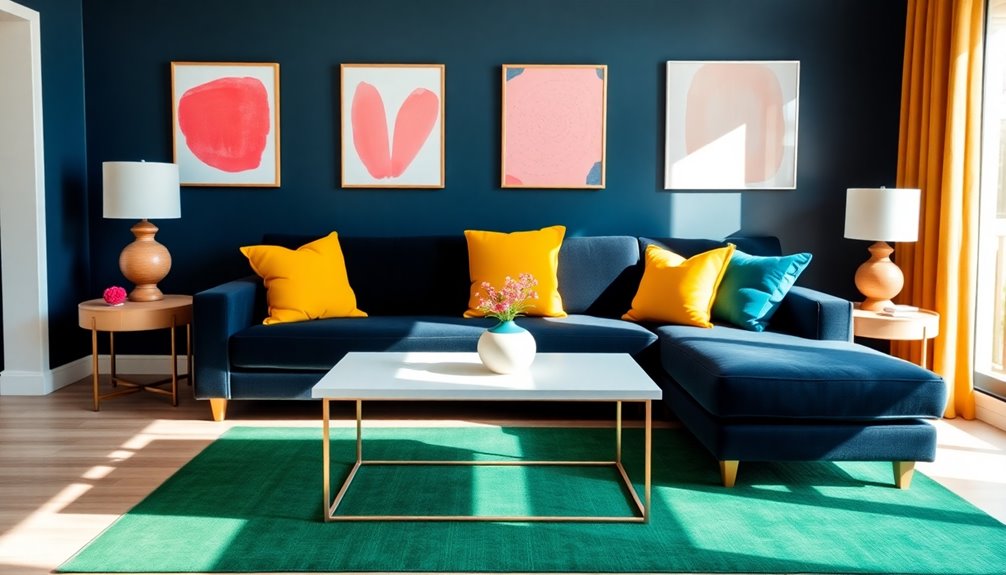
When you think about strategic color placement, accent walls can become powerful focal points that draw attention without overwhelming your space. Pairing bold hues with geometric shapes adds visual interest and can make your room feel more dynamic. Incorporating natural materials such as wood and bamboo can enhance the overall aesthetic while maintaining a balanced color scheme.
Accent Walls Impact
Accent walls can transform a room, especially when strategically placed to highlight architectural features like fireplaces or built-in shelves. By using a bold color that ties in with the overall design, you create a striking focal point that draws the eye.
Make sure the accent wall contrasts with lighter or neutral surroundings to amplify its impact. To achieve clean edges and sharp lines, use painter’s tape during application; this precision elevates the room’s aesthetic.
Consider the room’s lighting, as natural light can alter how a color appears throughout the day, influencing the mood. Limit accent walls to one or two per room to maintain balance and prevent overwhelming the overall design. Additionally, incorporating natural elements can further enhance the calming effect of your space.
Geometric Shapes Appeal
Geometric shapes can breathe new life into your interior spaces, providing a modern touch while defining distinct areas within a room.
By strategically placing vibrant colors within these geometric shapes, you can draw attention to specific architectural features, enhancing their visibility.
Larger shapes help maintain a clean, cohesive look, preventing a busy appearance that overwhelms the space.
Using painter’s tape guarantees precise lines and angles, giving your color blocking a polished finish.
When combining geometric shapes with analogous colors, you create a harmonious flow that avoids harsh contrasts while still adding visual interest.
This approach allows you to enjoy a balanced design that feels intentional and organized, perfect for today’s contemporary homes. Additionally, incorporating color psychology can further influence the mood and perception of your space.
Highlighting Architectural Features
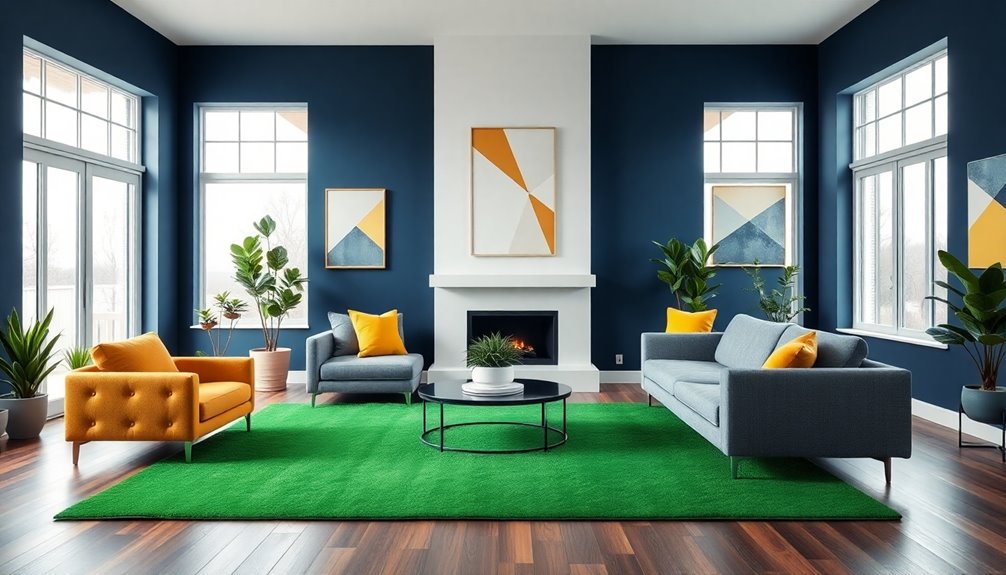
To highlight architectural features effectively, consider using bold accent walls that draw attention to unique elements like arches or built-in shelves. By incorporating color blocking techniques, you can emphasize these designs without overwhelming the space. Use paint around moldings or windows in contrasting shades to create a defined outline, showcasing their beauty. Lighter shades can highlight unique features, while darker tones offer depth. Explore a single bold hue that complements your room’s theme for cohesion. Additionally, using unique textures in your decor can further enhance the visual interest and depth of these features.
| Architectural Feature | Color Choice | Emotional Impact |
|---|---|---|
| Arches | Vibrant Red | Energy and Warmth |
| Built-in Shelves | Soft Blue | Calm and Serenity |
| Columns | Bright Yellow | Cheerful and Inviting |
| Beams | Deep Green | Nature and Stability |
Creating Defined Spaces
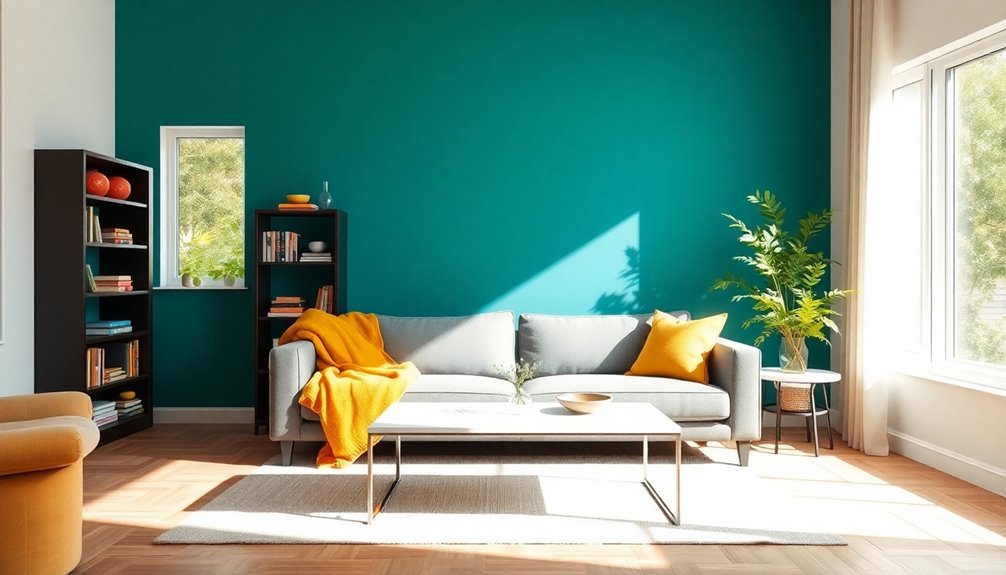
After highlighting architectural features, you can take your interior design further by creating defined spaces within larger rooms.
Using color blocking, you can apply contrasting colors on walls or furniture to establish distinct areas, like a cozy reading nook or a lively play zone. Incorporating abstract shapes and geometric patterns can enhance this visual separation, adding a playful touch.
Color blocking with contrasting hues can create vibrant spaces, like a cozy reading nook or an energetic play zone.
Extend color blocks to ceilings or architectural elements to emphasize these boundaries, drawing the eye effectively. Utilize color shifts between blocks to guide movement through the room and spotlight focal points.
Finally, by using similar colors or shades in adjacent areas, you maintain cohesion while still clearly defining each space. This approach guarantees your design remains intentional and engaging. Additionally, creating a distinctive decor style can further enhance the overall aesthetic appeal of your defined spaces.
Keeping It Balanced and Cohesive
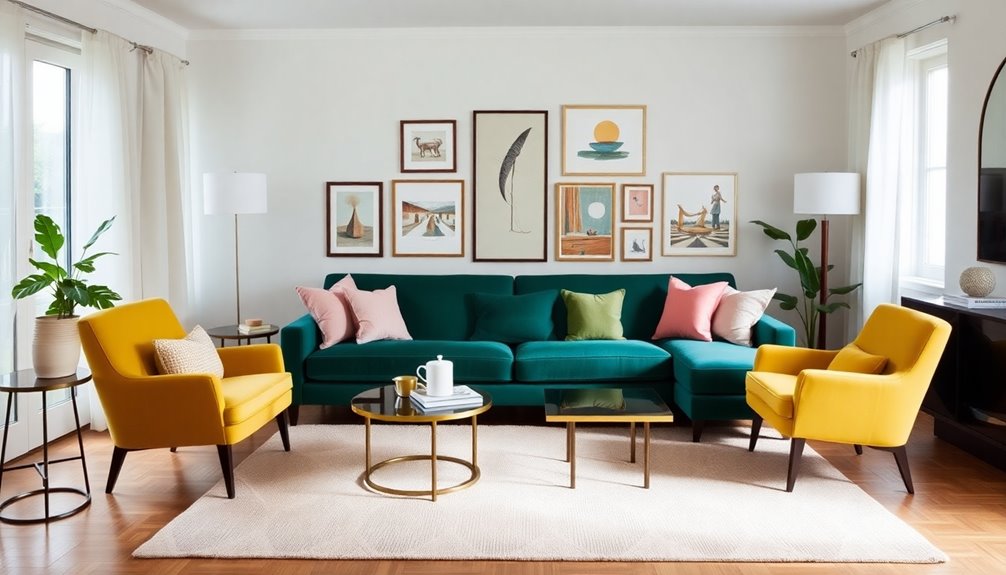
While diving into color blocking can be exciting, maintaining balance and cohesion is essential for a harmonious interior. Start with a limited color palette that features one dominant color and a few accent colors. This approach prevents overwhelming your space. Use neutral backgrounds to let those bold colors shine without competition. Repetition is key—incorporate your chosen colors in decor or furniture to visually tie different areas together. Apply color blocking sparingly; consider choosing an accent wall or select furniture pieces for focus. Keep in mind the room’s purpose and natural light, as these factors influence how colors affect the atmosphere.
| Strategy | Description | Example |
|---|---|---|
| Limited Color Palette | One dominant, few accent colors | Blue with yellow accents |
| Neutral Backgrounds | Calm base for bold colors | White walls |
| Color Repetition | Ties areas visually | Matching cushions |
| Focused Color Blocking | Specific areas for color application | Accent wall |
| Purpose & Light | Enhances atmosphere | Soft tones in bedrooms |
Experimenting With Patterns and Shapes
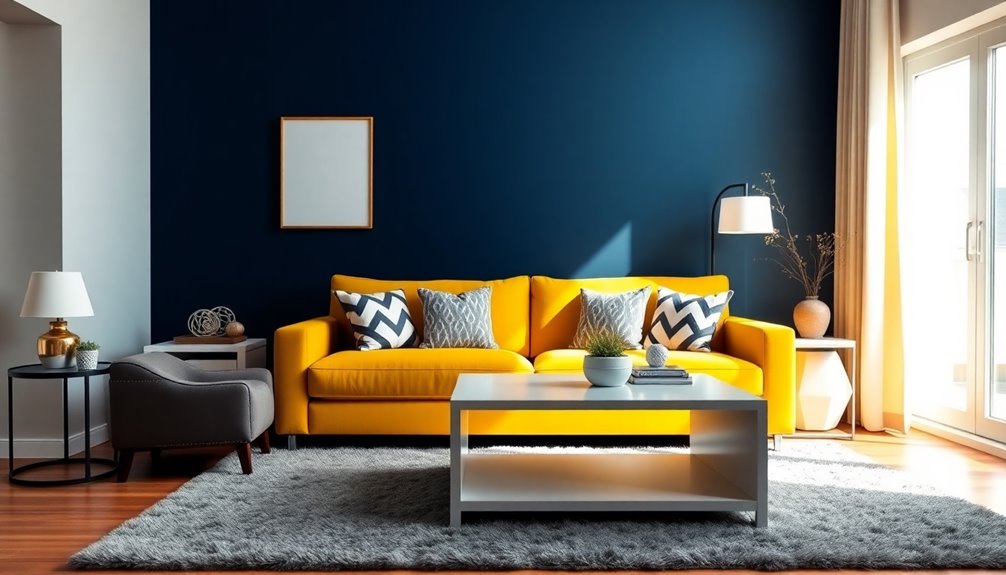
Experimenting with patterns and shapes can transform a room, adding depth and visual interest that color alone mightn’t achieve.
Use geometric designs to create a modern aesthetic without overwhelming your space. You can outline shapes with painter’s tape for clean edges that enhance your color blocking.
Incorporating stripes—horizontal, vertical, or diagonal—energizes a room and effectively defines different areas.
Layering colors in abstract shapes introduces playful elements while keeping a cohesive look, especially when using similar shades.
Don’t shy away from mixing solid colors with patterned fabrics or wallpapers; this creates a balanced, dynamic visual experience without cluttering your design.
Embrace patterns and shapes to elevate your color blocking to the next level.
Tips for a Successful Color Blocking Project

To achieve a striking color blocking effect, it’s important to approach your project with a clear plan. Start by sketching your design and using painter’s tape to outline the areas you want to block. This guarantees precision and a clean finish.
Here are some tips to keep in mind:
- Limit your color palette to three to five complementary colors for cohesion.
- Start small by testing color blocking in less prominent areas, like an accent wall.
- Incorporate neutral tones alongside bold colors to create balance.
Don’t forget to use accessories and decor that complement your blocked colors. This adds dimension to your interior design, tying the overall look together without relying solely on paint.
Happy decorating!
Frequently Asked Questions
What Are the Rules for Color Blocking?
When you’re diving into color blocking, stick to a maximum of three primary colors to keep things cohesive.
Plan your design carefully—sketch out where each color will go and use painter’s tape for clean lines. Balance those bold colors with neutrals to prevent overwhelming the space.
Don’t forget to take into account the room’s size and lighting, as these factors can dramatically affect how colors feel and interact in your environment.
What Is the 3 Color Rule in Interior Design?
Think of your room as a well-composed symphony, where each color plays its part.
The 3 Color Rule suggests you pick three colors for balance: a dominant color covering about 60% of the space, a secondary color making up around 30%, and an accent color for the remaining 10%.
This harmony creates a cohesive look, preventing visual chaos and making your space inviting and aesthetically pleasing.
Choose complementary colors for the best effect!
Is Color Blocking Out of Style?
Color blocking isn’t out of style; in fact, it’s thriving in 2023.
You’ll find it featured in contemporary spaces and on social media platforms, showcasing its versatility across various design aesthetics.
By intentionally using contrasting colors, you create visual interest and balance in your space.
As trends change, the foundational principles of color blocking—contrast, balance, and intentionality—remain timeless, ensuring its relevance in modern interior design discussions.
What Colors Are Best for Color Blocking?
Ever wondered which colors can transform your space?
For color blocking, you’ll want to choose complementary colors for a striking contrast, or go with analogous colors for a softer vibe. Neutrals can ground your design, making bold hues pop without overwhelming the room.
Also, consider different shades of a single color to add depth. Just remember to limit bright colors to a couple of focal areas to keep things visually appealing and organized.
Conclusion
Incorporating color blocking into your interior design can transform any space into a vibrant masterpiece, much like a modern-day Picasso brought to life. By choosing the right palette and strategically placing colors, you can create a balanced and cohesive look that highlights your home’s unique features. Don’t hesitate to experiment with patterns and shapes—just remember to keep it grounded. With these tips, you’re ready to release your inner artist and revamp your living space in style!
